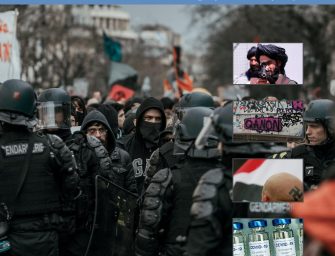#ReaCT2021 – Jihadist extremism in Europe. The concepts and importance of PVE/CVE
by Chiara Sulmoni, START InSight
 The concepts of preventing and countering violent extremism (PVE / CVE) gained prominence along with the growth of so-called homegrown radicalization and gradually became an integral part of the global anti-terrorism architecture, of which they represent the noncoercive side. The mobilisation of thousands of foreign fighters, sympathizers and would-be jihadists which unleashed a long string of attacks from 2015 onwards in Europe, pushed the two acronyms to the top of the agenda of international and regional organizations (such as the UN and the EU) and of individual countries alike. PVE and CVE developed into a proper professional field which today can rely on interdisciplinary, collaborative networks, the exchange of know-how among experts and, last but not least, substantial funding.
The concepts of preventing and countering violent extremism (PVE / CVE) gained prominence along with the growth of so-called homegrown radicalization and gradually became an integral part of the global anti-terrorism architecture, of which they represent the noncoercive side. The mobilisation of thousands of foreign fighters, sympathizers and would-be jihadists which unleashed a long string of attacks from 2015 onwards in Europe, pushed the two acronyms to the top of the agenda of international and regional organizations (such as the UN and the EU) and of individual countries alike. PVE and CVE developed into a proper professional field which today can rely on interdisciplinary, collaborative networks, the exchange of know-how among experts and, last but not least, substantial funding.
The efforts sustaining PVE and CVE are driven by the awareness that counter-terrorism measures based on military or police forces are insufficient to deal with the problem as we know it, as they do not address the origins and nature of the phenomenon (they can rather add to its motivations); moreover, the high number of extremists and the complexity of their profiles make it impossible to counter it with the sole tools of repression or intelligence; especially so, when perpetrators are lone-attackers who might act out on a spirit of emulation. The current terrorist threat in the West is fluid and stratified; it can both “materialize” through attacks borne out of a well-defined Islamist/jihadist context, or by means of individuals affected by personal distress rather than entrenched ideology. Europol points out that sometimes suspects arrested for propaganda have a long history of involvement in jihadist activities, including attempts to join the Islamic State on the frontline and the planning of violent actions. A comparative study on prisons and terrorism which examines the situation in 10 European countries (ICSR, 2020) recorded 22 prison-related attacks or plots over the past 5 years; 12 of these were carried out by recently released jihadists. The real proportions of recidivism -and how to deal with it- are currently a topic for debate. According to Neil Basu, head of counter-terrorism policing in the UK, “the real way to prevent terrorism is to get it right at the start of the radicalisation cycle.”
Limits and opportunities
 The objective of PVE essentially consists in pre-empting processes of radicalisation; activities can include educational projects or initiatives promoting social cohesion. CVE on the other hand refers to policies and programmes aimed at countering extremism with a view to preventing violence, therefore reducing the risk of terrorism (de-radicalization and counter-narrative fall into this category). In order to be effective, projects in both these sectors need to be very knowledgeable about the reality they intend to influence, and its constant evolution. Hence, the importance of dialogue (and mutual listening) among researchers, practitioners, law enforcement agencies and legislators on issues such as the mechanisms and contexts affecting radicalization and recruitment but also on defining priorities, expectations, training necessities, methodologies and supervision, so that all this work which involves different actors (NGOs, public and private institutions, civil society) and a wide range of “proposals” with a preventive potential, can find some continuity and represent more than just virtuous experiments. Measuring the results of PVE initiatives remains a difficult task (the same holds true for de-radicalisation); assessing the relevance of an intervention aimed at preventing a “fact” from happening is a complex exercise, which must take into account many variables -from individual psychology to the organizational or financial difficulties a program can run into. This issue is already keeping many European think tanks busy.
The objective of PVE essentially consists in pre-empting processes of radicalisation; activities can include educational projects or initiatives promoting social cohesion. CVE on the other hand refers to policies and programmes aimed at countering extremism with a view to preventing violence, therefore reducing the risk of terrorism (de-radicalization and counter-narrative fall into this category). In order to be effective, projects in both these sectors need to be very knowledgeable about the reality they intend to influence, and its constant evolution. Hence, the importance of dialogue (and mutual listening) among researchers, practitioners, law enforcement agencies and legislators on issues such as the mechanisms and contexts affecting radicalization and recruitment but also on defining priorities, expectations, training necessities, methodologies and supervision, so that all this work which involves different actors (NGOs, public and private institutions, civil society) and a wide range of “proposals” with a preventive potential, can find some continuity and represent more than just virtuous experiments. Measuring the results of PVE initiatives remains a difficult task (the same holds true for de-radicalisation); assessing the relevance of an intervention aimed at preventing a “fact” from happening is a complex exercise, which must take into account many variables -from individual psychology to the organizational or financial difficulties a program can run into. This issue is already keeping many European think tanks busy.
























There are no comments
Add yours